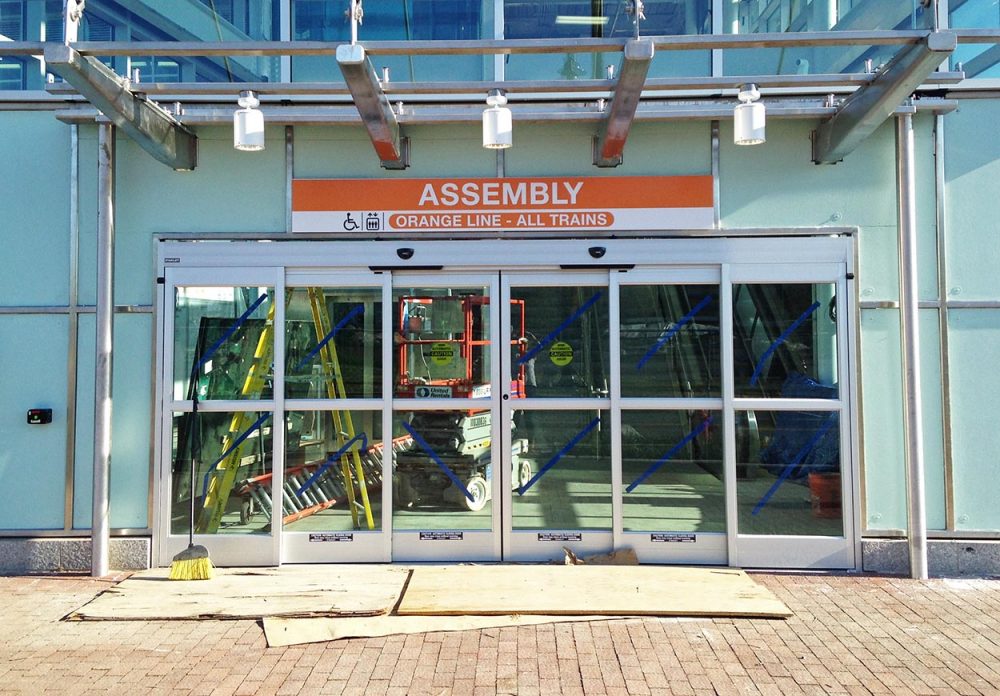Advertisement
New MBTA Station The Capstone Of Somerville's Assembly Square Development

The MBTA’s first new rapid transit station in 27 years, at Somerville’s Assembly Square, is set to open before the end of the summer, a T spokesman said Friday. One of six new stations slated for Somerville in the next decade, the city is trying to take advantage of that development opportunity in a way that doesn't sacrifice the community's economic diversity.
The $29.2 million Orange Line station, a 10-minute ride from downtown Boston, lies between Wellington Circle and Sullivan Square. It's predicted to serve 5,000 passengers on typical weekday by 2030.

The station is the capstone of the massive $1.5 billion Assembly Row development, which planners expect will ultimately feature up to 2,100 residential units, a hotel, 1.75 million square feet of office space and 500,000 square feet of retail and restaurant space — including a Legoland Discovery Center, a 12-screen movie theater and a beer garden.
“Without the T station, the scale of development would be a lot different and the returns would be a lot less,” Somerville Mayor Joseph Curtatone said.
It's a big change for the area. In 1980, the city of Somerville declared Assembly Square "blighted, substandard and decadent."
“If you were to go back 10 years, nobody was going to build any T stop there because there wasn’t anything there," said Danny LeBlanc, CEO of the Somerville Community Corporation, which works to keep housing affordable for the city’s low-income population. "And so there was a pretty long standing chicken and egg story that has now played out to the point where the viability of having a vibrant district there, with people living and working and so forth, would warrant actually stopping a subway line there.”
The Green Line extension project is scheduled to bring two more rapid transit stations to Somerville in 2017, and three more after that. Curtatone says those added stops will boost the percentage of the city’s population living within walking distance of a T station from 15 percent to 85 percent.
But those new transit stops are also expected to boost rents in a city where 67 percent of households don’t own their homes, and 44 percent of those renters are already considered housing-cost burdened, meaning they spend more than 30 percent of their household income on housing costs, according to a recent study from the Metropolitan Area Planning Council.
“If you were to go back 10 years, nobody was going to build any T stop there because there wasn’t anything there.”
Danny LeBlanc, CEO of the Somerville Community Corporation
The same study predicts rents around new Green Line stations could increase by as much as 67 percent, and warns that the loss of economic diversity could be "a significant negative impact" of the Green Line extension.
LeBlanc, the community development CEO, says the decisions the city makes during this time of explosive growth will be crucial.
“We need to learn the lessons of what happened in Davis and Porter squares, which was admittedly at a time when nobody really was as aware as we are today of the impacts of new transit on land values and housing costs,” LeBlanc said. “So we know that today, and the transit itself is a tremendous amenity ... and our really big concern is that low and moderate income people don’t get pushed out in the process.”
Curtatone says the city has been working to prepare, and that SomerVision, a 20-year strategic plan that he called Somerville's “shared set of hopes and dreams,” shows the city is committed to maintaining a community that is "multicultural in its essence, original, creative, innovative and a bit funky and freaky that we love."
Part of that, Curtatone said, is building 6,000 additional units of housing by 2030, 1,200 of which will be affordable. But he says the entire region needs to pitch in.
“The Greater Boston region ... has a need, a well spelled-out and studied need of 435,000 units of housing by 2040,” Curtatone said. “If we do not as a region, undertake an approach much like what we’re doing here in Somerville, then the concerns that we have as a community about what we would lose, that certainly is going to happen across the region.”
And while the MAPC study shows that the number of low income households in Somerville was statistically unchanged from 2000 to 2010, home values are on the rise. According to data from the real estate data tracking firm The Warren Group, the median price of a single family home in the city rose 27 percent between 2005 and 2013, from $428,500 to $544,350. And rent for a studio apartment at the new Assembly Row development starts at $1,900 a month.
The MAPC study observed that many Somerville residents were concerned these trends were accelerating, but LeBlanc maintains that with so much demand on the city’s housing stock, any new development is good.
"[Assembly Row] gives us a little bit more breathing room to try to address what I regard as a really big problem, which is that as properties — especially the small two-, three-, four-family homes — turn over, those prices are also going to be bid up dramatically as they get sold, and rents are going up," he said. "I want to be the first to say there aren’t any magic bullet answers to that [problem,] but I think simply having more housing helps at least buy time."
Related Coverage:
Correction: An earlier version of this story incorrectly reported the number of years since the MBTA last opened a rapid-transit station. It's been 27 years.
